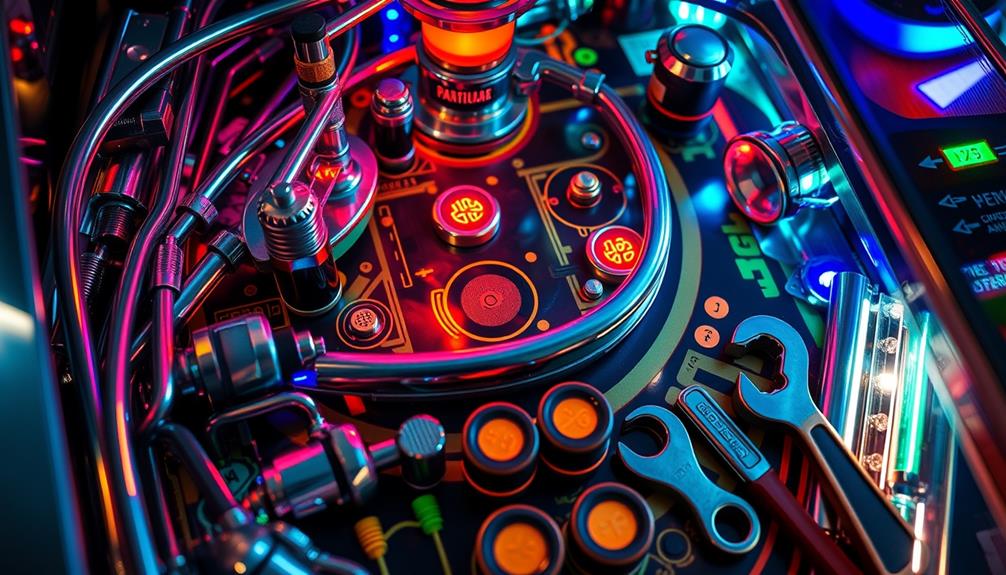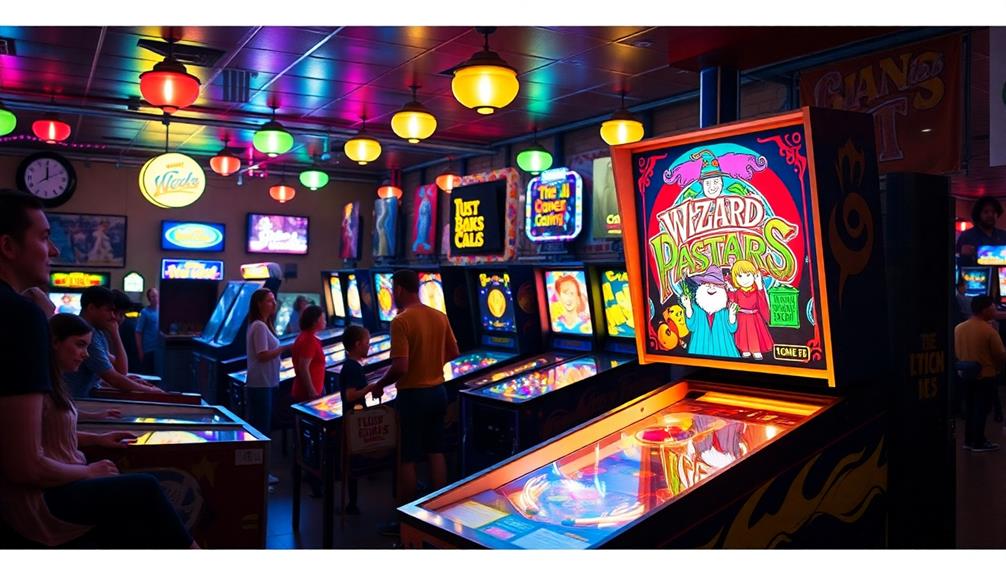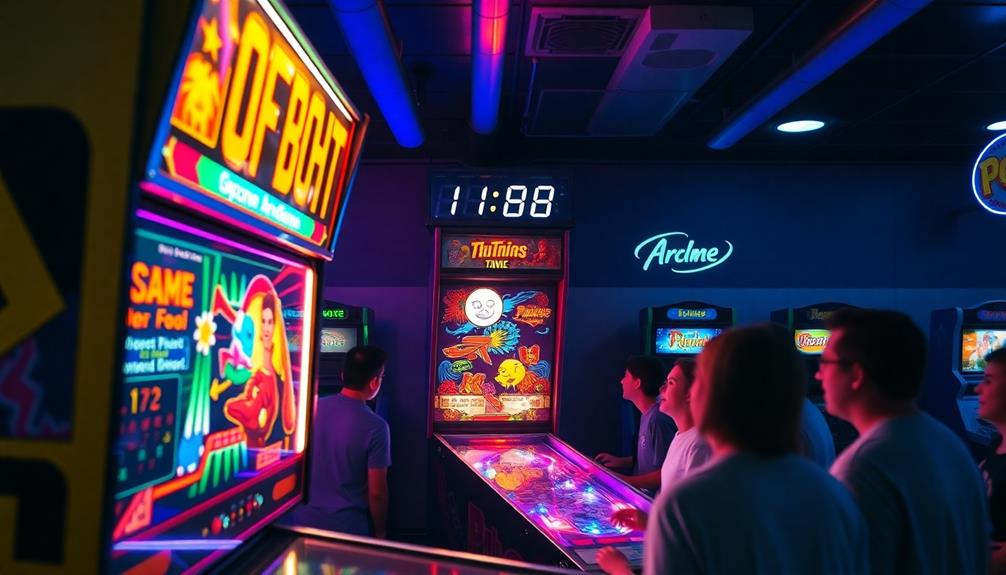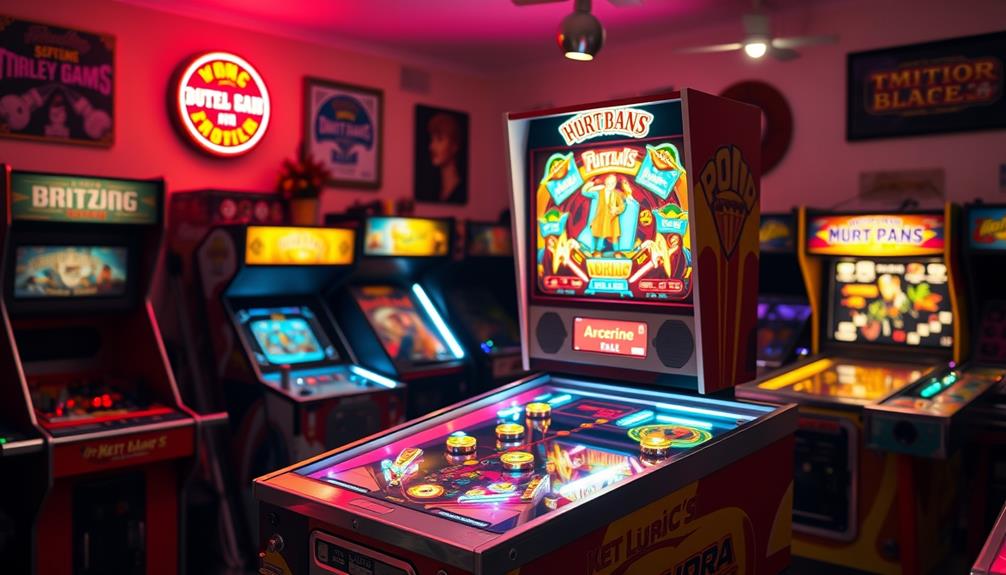Yes, pinball machines do require regular maintenance to ensure they stay in optimal condition. It is important to clean the playfield regularly and check for worn rubber rings or burnt-out bulbs. The frequency of cleaning will depend on how often the machine is used, ranging from every few weeks to a few months. It is also necessary to adjust mechanical components for smooth gameplay. Even though this may seem like a lot of work, staying proactive with upkeep can help prevent costly repairs in the future.
If you are interested in learning more about specific maintenance tasks and required tools, there is plenty of information available on the topic. When it comes to cleaning the pinball playfield, it is crucial to use the appropriate products and techniques to avoid causing any damage. Regularly vacuuming loose debris and using a non-abrasive cleaner will help maintain the integrity of the playfield. By practicing proper care and maintenance, you can ensure that your pinball machine continues to provide enjoyment for many years to come.
Key Takeaways
- Pinball machines require regular maintenance to prevent dust buildup and mechanical issues, ensuring smooth gameplay.
- Common tasks include cleaning components, replacing rubber rings, and monitoring light bulbs, which can be time-consuming.
- Proactive maintenance helps avoid costly repairs and minimizes downtime, making routine care essential.
- Inspecting components regularly aids in early identification of potential problems, demanding attention and maintenance efforts.
- While maintenance is necessary, having the right tools and a schedule can streamline the process and reduce workload.
Importance of Regular Maintenance
Regular maintenance is vital for keeping your pinball machine in top shape. Dust accumulation can lead to wear and mechanical malfunctions, which is why you should clean your pinball machine regularly.
By conducting quarterly cleanings and annual deep cleanings, you can greatly prolong the life of its components and enhance your gameplay experience. Additionally, understanding the importance of budgeting for maintenance can help guarantee that you set aside enough funds for necessary repairs and upkeep.
Engaging in proactive maintenance helps you avoid costly repairs and downtime. It's essential to keep a digital log of your maintenance activities, so you can track issues like burnt-out bulbs or broken rubber.
This way, you can address problems promptly, preventing them from escalating into more serious damage. Regular inspections also allow you to identify potential issues early, such as loose screws or worn rubber rings.
Common Maintenance Tasks

To keep your pinball machine running smoothly, several common maintenance tasks should be routinely performed. Regularly cleaning the playfield and replacing worn parts like rubber bumpers and flippers can help ensure your pinball machine stays in top condition. Additionally, performing regular inspections to check for loose connections or malfunctions can help catch potential issues before they become major problems. If you’re thinking about purchasing a used pinball machine, there are a few tips for buying a used pinball machine that can help ensure you’re making a smart investment. Research the specific machine you’re interested in, inspect it in person if possible, and consider having a professional technician evaluate its condition before making a purchase.
First, you need to clean your playfield and its components regularly—every 2 to 90 days, depending on usage—to prevent wear and extend the machine's lifespan. Regular maintenance can also help avoid unexpected repair costs, similar to the significance of choosing a plan that covers essential appliances in your home.
Next, check the rubber rings, especially those for flippers and slingshots. You should replace these every few months to guarantee peak gameplay performance and responsiveness.
Additionally, monitor the light bulbs; replacing them as needed is vital. Consider using LED bulbs since they last longer and are more efficient than traditional incandescent ones.
Adjusting mechanisms is another key maintenance task. Over time, moving parts can become misaligned, so make sure everything is functioning smoothly during gameplay.
Keeping a supply of spare parts, like fuses, bulbs, and rubber rings, on hand is also a smart move. This way, you can quickly replace any faulty components, minimizing downtime and keeping the fun going.
Tools Needed for Repair
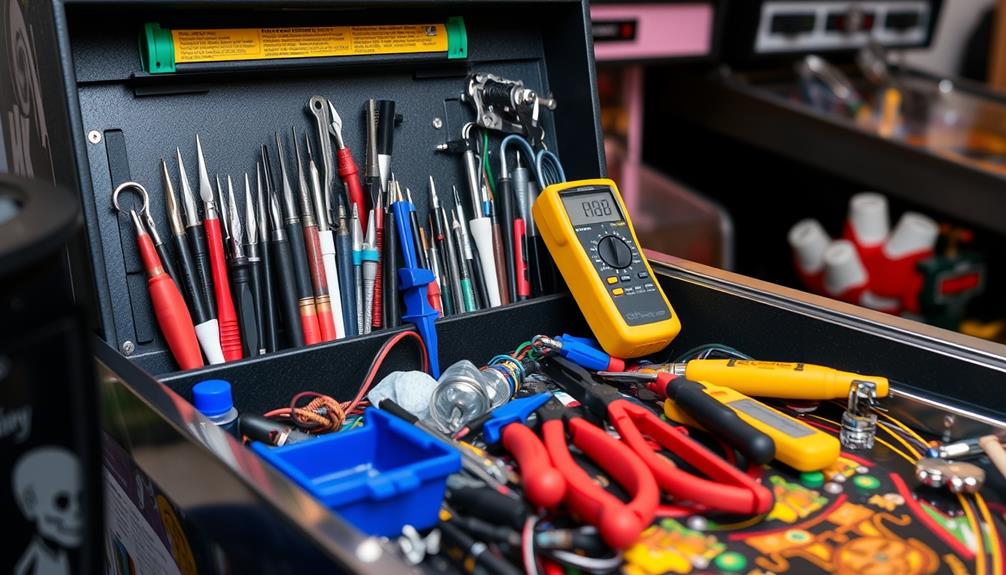
When it comes to repairing pinball machines, having the right tools is key.
You'll need high-quality screwdrivers, pliers, and wrenches to handle most tasks, along with specialized equipment like a soldering iron for electrical issues.
A multimeter can also be invaluable for diagnosing problems and ensuring everything runs smoothly.
Additionally, possessing strong problem-solving skills and a methodical approach is beneficial when troubleshooting various components, which is essential in the importance of quality assurance during repairs.
Essential Tools Overview
Maintaining and repairing pinball machines requires a solid set of essential tools to keep everything running smoothly. With the right tools at your disposal, you can tackle routine maintenance and repairs effectively.
Additionally, having a thorough understanding of the best vacuums for dust removal in 2024 can help you maintain a cleaner environment for your machines.
Here's a list of must-haves for your toolkit:
- Basic hand tools: Screwdrivers, pliers, and wrenches are vital for most repairs.
- Soldering iron: Perfect for repairing electrical connections and components.
- Multimeter: A valuable device for diagnosing electrical issues, checking voltage, and measuring continuity in circuits.
- Switch change tool: This handy tool simplifies the replacement of faulty switches, making your maintenance tasks easier.
- Tool maintenance supplies: Regularly inspect and maintain your tools to prevent damage to fasteners and machine components.
Specialized Repair Equipment
Specialized repair equipment is vital for tackling the unique challenges that come with fixing pinball machines. You'll need a variety of tools for both basic maintenance and complex repairs. Key items include screwdrivers, pliers, wrenches, and a soldering iron. A multimeter is also essential for diagnosing electrical issues, enabling you to check voltages and continuity in circuits.
To help streamline your repair process, consider the following tools:
| Tool | Purpose |
|---|---|
| Switch Change Tool | Simplifies replacing faulty switches |
| Soldering Iron | Repairs electrical connections |
| Multimeter | Diagnoses electrical issues |
Regular inspections of your tools can prevent damage and guarantee safe handling during repairs. It's also wise to keep a supply of common replacement parts, such as bulbs, rubber rings, and fuses, on hand. This practice facilitates quicker repairs and minimizes downtime for your pinball machine. By investing in specialized equipment, you can tackle maintenance tasks effectively and keep your machine running smoothly.
Understanding Pinball Machine Components
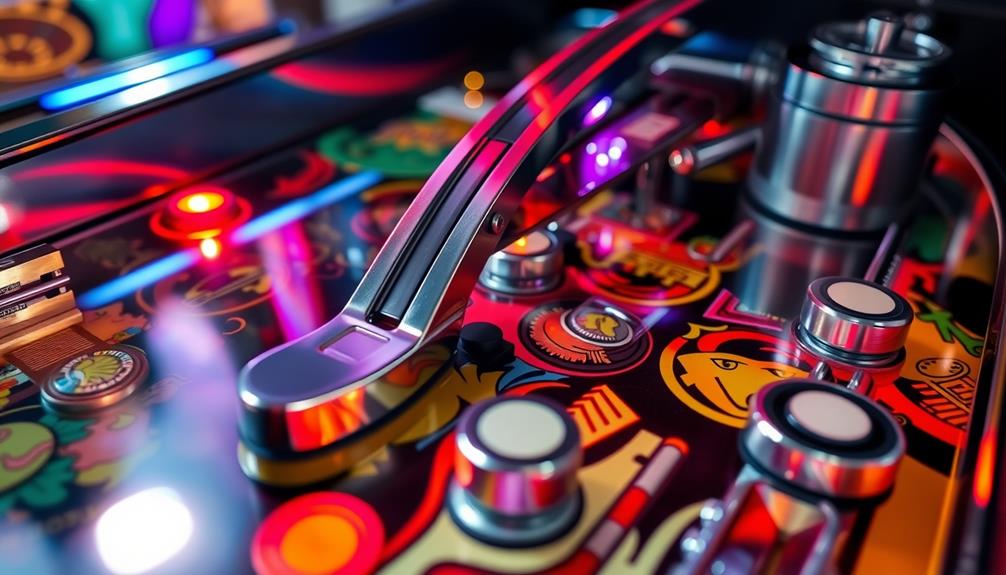
Understanding the various components of a pinball machine is fundamental for anyone looking to enjoy or maintain one. Each part plays a significant role in gameplay and requires regular attention to guarantee everything runs smoothly.
Maintaining a pinball machine involves recognizing the importance of content quality and topical authority to enhance your knowledge and performance.
Here are the key components to know:
- Cabinet: Houses important mechanical parts like flippers and bumpers; its stability is essential for gameplay.
- Playfield: The main area for the game, needing frequent cleaning and maintenance to prevent dust and wear.
- Backbox: Contains the scoring and display mechanisms, which can be costly to replace; inspect for burnt components regularly.
- Rubber rings: Provide bounce for the ball; worn or defective rings must be replaced to maintain performance.
- Electrical components: Include circuit boards and wiring; inspect them for damage or unsoldered connections to prevent malfunctions.
Understanding these components helps you identify potential issues and perform necessary maintenance.
Cleaning Procedures and Tips

To keep your pinball machine in top shape, regular playfield cleaning is a must. You should aim to vacuum or blow off dust every couple of weeks, especially if you play often.
Additionally, ensuring that your machine's components are free from grime can greatly enhance the game's performance, much like how fuel injection cleaning benefits vehicle efficiency.
Don't forget about the backbox; proper maintenance there can enhance your overall gameplay experience.
Regular Playfield Cleaning
Regular playfield cleaning is essential for maintaining the performance and longevity of your pinball machine. Dust accumulation can lead to wear and tear, reducing the lifespan of your components.
Additionally, regular maintenance can enhance your overall gaming experience, similar to how various brewing methods impact the flavor of coffee different brewing methods.
To guarantee effective maintenance, it's recommended to clean the playfield every 2 to 90 days, depending on usage. Here are some tips to help you with the process:
- Use a soft, lint-free cloth or microfiber towel.
- Opt for mild cleaners designed specifically for pinball playfields.
- Vacuum or blow dust off under moving parts and rubbers.
- Handle the glass covering carefully to prevent breakage.
- Document the playfield layout with photos before disassembly.
Backbox Maintenance Essentials
Maintaining the backbox of your pinball machine is crucial for guaranteeing reliable performance and safeguarding its internal components. Start by carefully removing the backglass using the key found on the coindoor. Handle it with care to avoid damage during cleaning or inspection.
Regular cleaning is essential. Here's a quick guide to help you:
| Task | Frequency |
|---|---|
| Vacuum dust | Monthly |
| Inspect components | Every few months |
| Change batteries | Annually |
When you vacuum, focus on the backbox, especially around the backbox cards and electronic components to keep dust at bay. While inspecting, look for burnt components and verify all connections are secure. If you need to change the batteries, do so with the machine powered on to retain settings and avoid data loss. Always choose appropriate cleaning solutions for the backbox glass to prevent color fading. After cleaning, reattach the glass securely to protect internal components. With these cleaning procedures and tips, you can guarantee your pinball machine stays in top shape!
When to Seek Professional Help
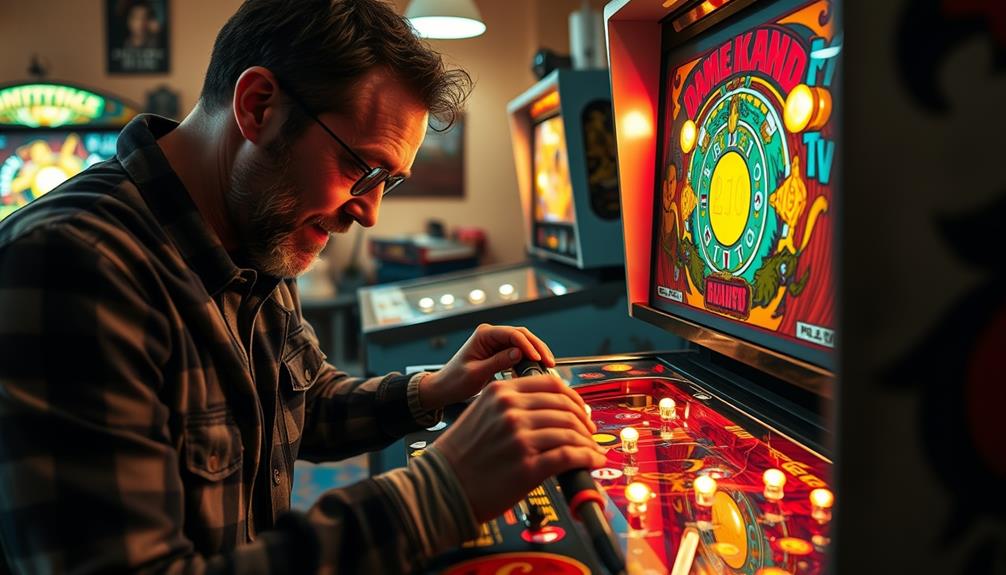
When dealing with pinball machines, knowing when to call in a professional can save you time and frustration. While basic maintenance can often resolve minor issues, some problems require expertise.
Understanding the importance of thematic coherence can also help you maintain the overall enjoyment of your gaming experience. Here are key situations where professional help is advisable:
- Persistent electrical issues: If you're facing malfunctioning displays or flipper failures that basic troubleshooting can't fix, it's time to call a pro.
- Significant mechanical jams: Complex mechanical problems or circuit board failures are best handled by someone with specialized knowledge.
- Cold solder issues: After extensive play (over 10,000 plays), these can arise. A professional inspection guarantees proper repairs.
- Node board failures: If you consistently need to replace node boards or require advanced diagnostics, a technician can save you time and guarantee quality work.
- Complex wiring or electronic issues: When you encounter problems beyond your maintenance skills, seeking professional assistance prevents further damage and guarantees safety.
Don't hesitate to reach out for professional help when you encounter these issues.
It'll keep your pinball machine running smoothly and enhance your gaming experience.
Frequently Asked Questions
How Often Do Pinball Machines Need Maintenance?
Pinball machines need maintenance regularly. You should clean them every 2 to 90 days, perform quarterly checks on components, and do an annual deep clean to keep everything running smoothly and enhance your gameplay experience.
What Is the Easiest Pinball Machine to Maintain?
If you're looking for easy maintenance, consider machines like Star Trek Pro or Metallica. Their simpler designs and modular components make repairs quick, while strong community support guarantees you'll find help and replacement parts easily.
How to Take Care of a Pinball Machine?
To take care of your pinball machine, clean the playfield regularly, inspect and replace worn parts quarterly, perform deep cleaning annually, and keep a digital log of maintenance activities to track its condition effectively.
Why Did New York Ban Pinball?
Imagine a bustling carnival, where pinball machines spark joy. Yet, in 1940, New York saw them as threats, fearing they'd lure youth into vice, leading to a ban that stifled this vibrant amusement for decades.
Conclusion
In the world of pinball, keeping your machine in top shape is like tuning a finely crafted guitar; a little care makes all the difference. Regular maintenance guarantees smooth gameplay and keeps your machine singing sweetly. Just like you wouldn't let a guitar collect dust, don't neglect your pinball machine. By investing time in upkeep, you'll enjoy endless hours of fun, and your machine will reward you with that satisfying "ding" after every successful shot.
